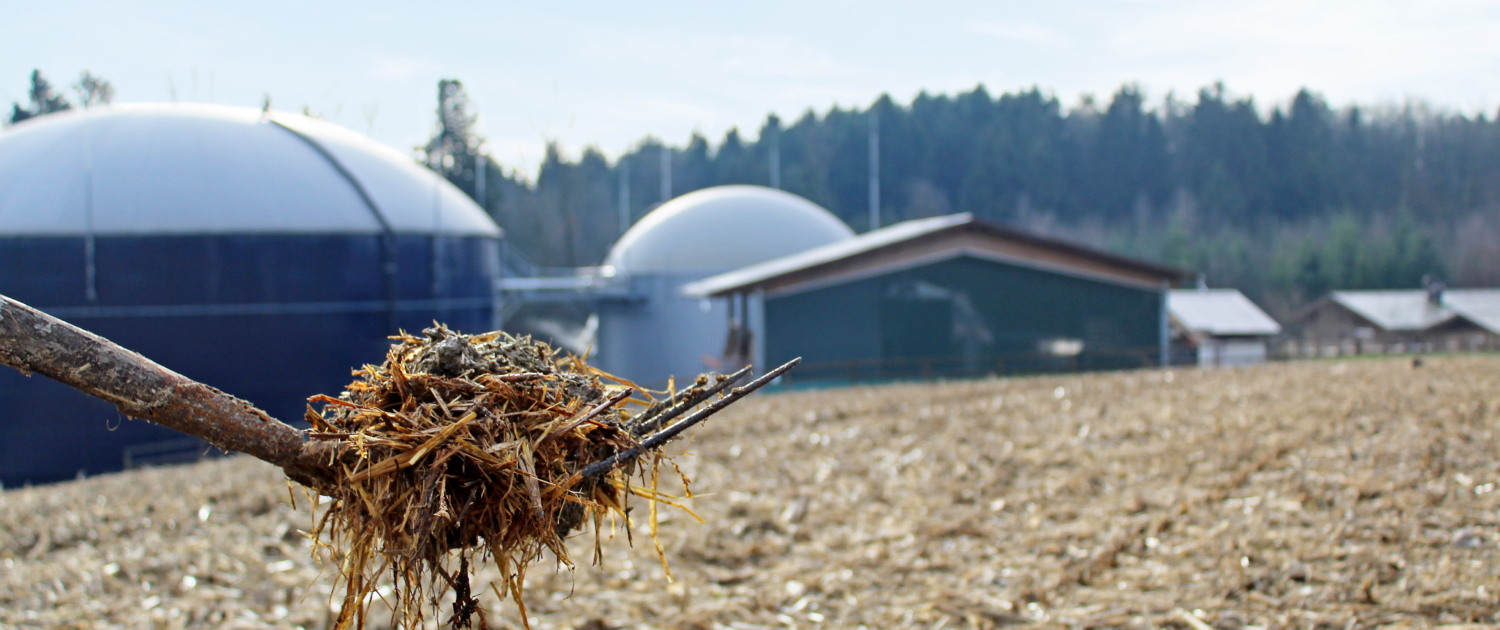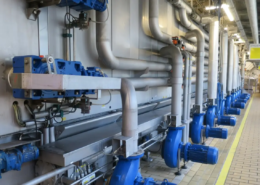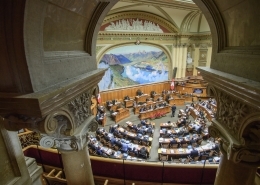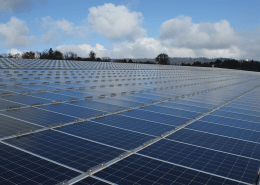In the past, a dung stick belonged to every farm. Today, farmers bring manure and dung from their livestock to a biogas plant. This is good for the climate. Because the greenhouse gas methane, which is released uncontrollably into the atmosphere during conventional storage and contributes to global warming, is converted into energy in this way. However, biogas plants are often not completely leak-proof either, and methane escapes. In what order of magnitude? Answers are provided by an international study co-financed by the Swiss Federal Office of Energy.
Germany, Austria, Sweden, Denmark and Switzerland took part in the study. In the project years 2018 to 2020, methane emissions were measured at over 30 agricultural biogas plants. Among them were three from Switzerland with an installed electrical capacity between 120 and 680 kW. The main finding: emissions vary depending on the plant, and they can differ within a day and also from day to day.
So-called remote measurements were carried out, but also on-site measurements were taken. Remote measurements revealed emissions of 0.4 to 0.5 kg of methane per hour during normal operation. Thus, the maximum values of the three investigated Swiss biogas plants are below those of the partner countries, where values of up to 10.4 kg methane per hour were measured.
Methane emissions from biogas plants occur, for example, in the event of leaks. However, emissions can also occur due to structurally non-gas-tight plant components such as substrate storage or digestate storage (the waste product of biogas production). Measurements on site clarified this. The gas-tight containers (fermenter, secondary fermenter, digestate storage) had no or very low emissions. Non-gas-tight fermentation residue stores, pre-pits, the combined heat and power plant exhaust air and, in one particular case, a defective double membrane were identified as the main sources of emissions.
It should be noted that the emissions measured were not related to gas production. This means that a high energy production did not automatically lead to more emissions than a low one.
Deborah Scharfy of the cooperative Ökostrom, the Swiss Association for Agricultural Biogas, is co-author of the report. Energeiaplus asked her what the results of the study mean and what they are used for?
Energeiaplus: There are already several studies on methane gas emissions from biogas plants. What is new about the study by Ökostrom Schweiz
Deborah Scharfy: What is new is that measurements were taken simultaneously in several countries within one project using the same two methods. The methane emissions determined are therefore comparable between the countries. This has not been done before.
How surprising are the results for you?
The main surprise was, as you mention at the beginning, that methane losses did not correlate with methane production. We had expected a tendency either for larger plants to have proportionally lower losses than smaller plants or the other way round. Either because larger plants have to function well to recoup the investment and therefore have fewer emissions. Or because smaller plants are more manageable and controllable. Neither was the case. In concrete terms, this means that emission control is equally important for every plant, whether large or small.
How representative are the measurements of the three Swiss biogas plants for the rest in our country?
Three doesn't sound like many at first, and these three alone are not representative of all plants. In total, we currently have more than 100 agricultural biogas plants in operation in Switzerland. Since this is the very first time we have tried out the remote measurement method in this country, and since it involves a great deal of effort, we have only measured three plants. However, the idea behind the cooperation with the other countries was precisely that everyone in the project should learn from the measurements of the others and that the measurement results could be used for the evaluation. In total, 25 biogas plants were analysed by remote measurement in the project.
From manure to biogas:
Today, about 5 percent of the farmyard manure produced in Switzerland is used for energy.
The potential for the energetic use of manure and dung is still great. In 2020, there were 119 agricultural biogas plants in Switzerland (SFOE statistics). They produced 176 GWh of electricity in 2020 (SFOE statistics).
How can methane emissions best be prevented?
First of all, a distinction must be made between leakages and fugitive emissions. Leakages are leaks in components that are in principle leak-proof. These can be detected by leakage checks and remedied with appropriate measures. Diffuse emissions from non-gas-tight components such as pre-pits or fermentation residue stores - where the material is stored before and after the fermentation process - cannot be prevented per se, but they can be reduced. So-called management factors are then required. The longest possible retention time in the anaerobic, i.e. gas-tight system, so that the residual gas potential becomes small, is a well-known method. Feeding into the gas-tight system as quickly as possible is another low-emission approach, i.e. keeping storage times as short as possible before feeding into the biogas plant. Investments in additional anaerobic tanks are of course also an option, depending on the availability of farmyard manure and the cost-benefit ratio.
You address the cost-benefit ratio. Methane escaping from a biogas plant is harmful to the environment. But it's also a cost factor
That is true. Methane losses are always also energy losses and these have to be minimised because we want to use or sell the energy. So it is in the plant operator's own interest to minimize losses. Leakage detection helps to identify emission sources and thus also maintenance-relevant elements.
However: Our study also showed that large investments (e.g. for the gas-tight covering of a fermentation residue storage facility) can only be recouped if, in addition to the remuneration for the energy product (electricity price), there is also further remuneration, for example viaCO2 certificates.
Our agricultural biogas plants in Switzerland receiveCO2 certificates if they are registered as climate protection projects and can document their climate protection contribution. This is verified by external bodies.CO2 certification is a good incentive for low-emission biogas production.
Is zero emission even possible?
First of all, it should not be forgotten that biogas plants save many times more methane and convert it into usable energy than farmyard manure, which is not fermented in biogas plants and releases methane into the environment "unmolested". Biogas plants, as they are operated in Switzerland, with at least 80% farmyard manure, are primarily climate-protective!
The question of zero emissions: theoretically, this is possible with plant components that are designed to be gas-tight. Practically, however, it is not, since wear, corrosion, or material fatigue always occur. Nevertheless, we could clearly show in the project that it is not the gas-tight designed plant components which were the emission "leaders", but the components which were not designed gas-tight or cannot be designed emission-free, e.g. pre-pits or digestate storage. Pre-pits must be designed to be ventilated and must not be gas-tight.
Those who bring their farmyard manure to a biogas plant and do not store it conventionally on a dung heap are "rewarded" with climate protection benefits - precisely with this CO2 certificate. What is the significance of the study against this background?
The focus on emissions bears the risk that the results for biogas plants will be interpreted negatively. However, the measurement results in Switzerland showed that 97-98.5% of the methane produced in biogas plants is also utilised. And if we consider that a biogas plant reduces the methane emissions of a conventional farmyard manure storage by an average of 80%, this is a considerable achievement, and the climate protection benefits have clearly been achieved and should also be rewarded.
In addition, as mentioned above, they can help support certain emissions reduction investments that cannot be recouped purely through the sale of the energy product. The lowest emissions measured on a plant in this project were 0.4% of the methane produced, meaning 99.6% of the methane produced could be recycled. So that's our best practice level!
For whom are the results relevant?
First of all, for the whole biogas sector, also on a European level. From the plant constructors, to the manufacturers of CHP plants, to the plant operators. We also cooperated with the European Biogas Association in the project in order to increase the reach. Of course, the results are also particularly relevant for the biogas trade associations, and various activities around leakage detection and emission reduction have been expanded. The results are also relevant for the Federal Office for the Environment, which is compiling the national greenhouse gas inventory.
In parallel to the measurements, Ökostrom Schweiz has set up an industry concept with a voluntary methane measurement programme for agricultural biogas plants. What are the hopes for this?
Since escaping methane cannot be seen, special measuring equipment is needed. As a trade association, we have therefore purchased methane measuring devices that can detect even the smallest methane concentrations. These then also help to check the tightness during revision work or new buildings. Since climate protection and climate protection projects are central elements of our philosophy and quality assurance, preventive measures such as leakage detection are a means of meeting this requirement. In addition, the emission measurements help us in the long term to better understand the plants on the basis of data analysis and to provide advice for the low-emission operation of biogas plants.
The EvEmbi project
The project was funded within the 11th ERA-Net Bioenergy Joint Call under the topic "Bioenergy as part of a smart and flexible energy system" and ran under the title EvEmbi (Evaluation and reduction of methane emissions of different biogas plant concepts in Europe).
The partner countries Germany, Austria, Sweden, Denmark and Switzerland together analysed more than 30 biogas plants, both agricultural and commercial/industrial, for methane losses and reduction potentials.
The methods used to determine methane emissions followed a guideline for harmonised measurement methodology. The IDMM = Inverse dispersion modelling method, a remote measurement method with lasers and the on-site method were applied. In the IDMM, total emissions and emission factors were determined for the investigated plants and in the on-site methodology emission factors were determined for individual plant components.
In Sweden, Switzerland and Denmark and there has been a voluntary methane measurement program for biogas plants since 2007, 2011 and 2016. Through the project, a voluntary measurement programme has also been established in Austria.
Text and interview: Brigitte Mader, Communication, Swiss Federal Office of Energy
 zvg Oekostrom
zvg Oekostrom
 ShutterstockLe marché 2019 du photovoltaïque sous la loupe
ShutterstockLe marché 2019 du photovoltaïque sous la loupe  FeldschlösschenWie Wärmepumpen zur Energieeffizienz der Bierproduktion beitragen
FeldschlösschenWie Wärmepumpen zur Energieeffizienz der Bierproduktion beitragen  parlement.chHerbstsession 2019: die Energiethemen im Rückblick
parlement.chHerbstsession 2019: die Energiethemen im Rückblick  EnergieVorbild Première: 4 TWh d’électricité grâce aux nouvelles énergies renouvelables
EnergieVorbild Première: 4 TWh d’électricité grâce aux nouvelles énergies renouvelables 
 ©Béatrice Devènes
©Béatrice Devènes Schweizerischer Wasserwirtschaftsverband
Schweizerischer Wasserwirtschaftsverband
Dein Kommentar
An Diskussion beteiligen?Hinterlassen Sie uns Ihren Kommentar!